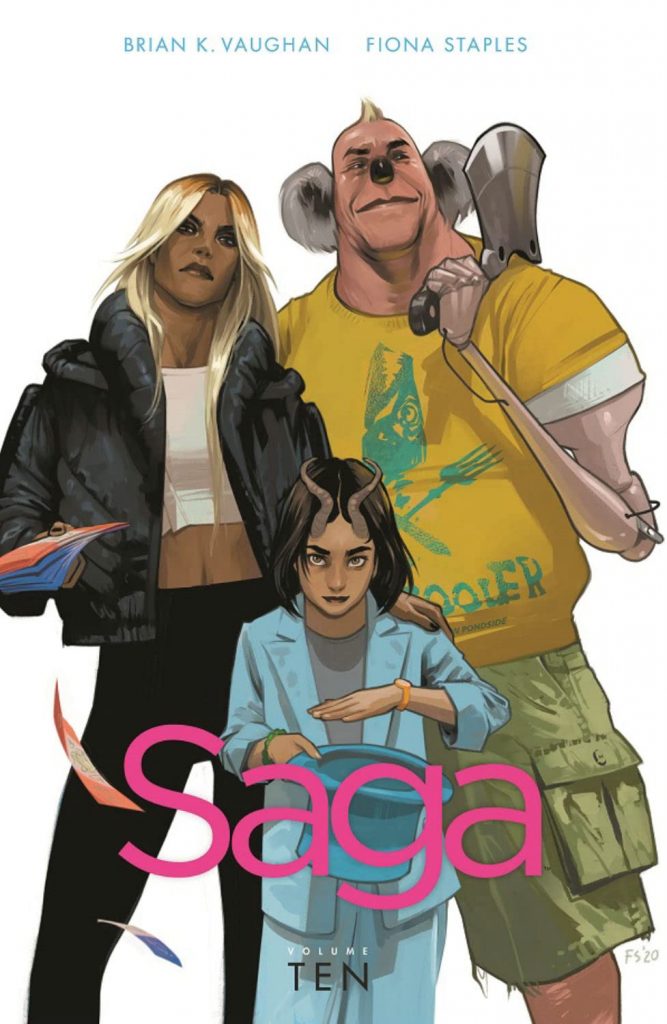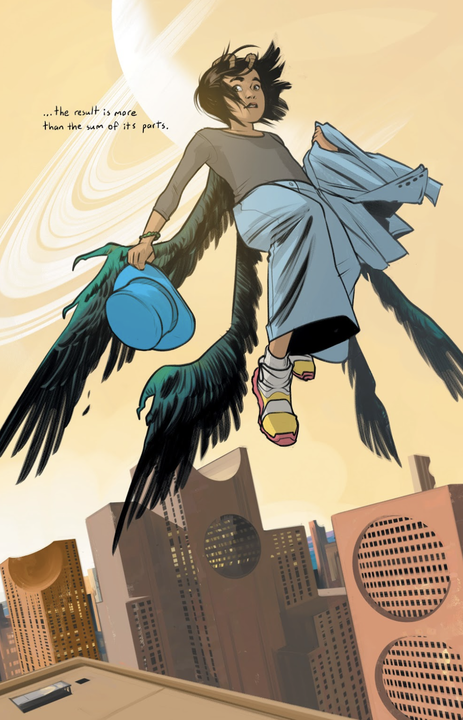This year marks the tenth anniversary of Saga, the wacky space opera that has cemented its reputation as arguably the most popular indie comic to emerge in the last decade. The comic made its return earlier this year with Issue #55 after being on hiatus since 2018. It’s easy to worry that, as one of the most highly anticipated comebacks in the comics world, Saga would struggle to live up to its well-deserved hype. But with the release of Volume 10 in early October, creators Brian K. Vaughn (Runaways, Paper Girls) and Fiona Staples (T.H.U.N.D.E.R. Agents, Archie) proved that the comic remains as incomparable as it’s always been: just as graphic, heartfelt, imaginative, violent, hilarious, and unadaptable as ever. This volume compiles the six issues released earlier this year and marks the halfway point of Saga’s current intermission, making now the perfect time for fans old and new to catch up before Issue #61 is published next January.

Volume 9 ended by giving readers a three-year-long cliffhanger to grapple with, and Volume 10 finds the main cast navigating its consequences three years later in story time. Narrator Hazel is now ten and is certainly growing up to be her mother’s daughter. The strong-willed, wild nature of young Hazel is an interesting contrast to her measured narration from the future, which guides the audience as her family continues to crisscross a war-torn universe, running from bounty hunters and finding less than legal ways to keep food on the table. While plot elements like these could quickly turn depressing, Saga is anything but—its strength continues to be its willingness to let characters experience life fully and vibrantly, no matter the situation. In this volume explosive, graphic violence is met by moments of equally animated passion and love (some of which might be the most x-rated in the series so far, quite the accomplishment given the comic’s history of censorship battles). While a quick glance at the page may make an unfamiliar reader view these panels as gratuitous, their context matters: Saga has made it clear that explicit scenes serve as the natural inverse to violent ones. The more people kill one another, the more people get it on. This frame was established many issues ago with one character’s epiphany that the opposite of war isn’t peace, but—to restate with a G-rated word—creation.
Being a story set in the midst of an endless war, Saga has never steered clear of political commentary. Volume 10 keeps it at the forefront with themes of imperialism, anti-monarchism, and the ethics of the drug trade woven throughout. One new character is clearly meant to mirror a recently growing group of “anti-woke” reactionaries, which becomes evident after he follows up the single worst sentence in the series with a sarcastic comment about “trigger warnings.” In a different scene, protagonist Alana discovers she isn’t the only person who believes in a conspiracy that military officials are releasing poisoned batches of illegal drugs to kill potential recruits on the opposing side. There’s another longer, more subtle thread about the dehumanization required by war: soldiers with the Landfall Coalition refer to a horned civilian from their enemy planet Wreath as “it,” and one character’s body is disrespected in very jarring ways by powerful people who see them as a political token.

Saga does best when it refuses to allow a modicum of anything normal to cross its pages, all while presenting overwhelmingly familiar feelings, dynamics, and behaviours. Volume 10 brings plenty of such moments: siblings dancing on their bedroom carpet to a stolen album blasting out of a giant conch shell; a band, whose members include a talking frog, a blue mole-woman, and a person with a television head, fighting over songwriting credits; a parent relaxing in the chaos of an arcade restaurant while children play with lizard hand puppets that shoot lasers. But Saga isn’t afraid to slow down and get serious when it needs to and continues to deliver impactful emotional punches. Underpinning the latest arc is a feeling of unaddressed grief that only gets the chance to surface in the last pages of the volume in one of the story’s most beautifully paced and poignant sequences to date. It’s a much-needed moment of cathartic release for characters and readers alike, and Fiona Staples’ stunning illustration brings it home.
At its core, Saga is a story about family and the village it takes to raise one very important child. Ten years in, Saga holds tight to these themes by exploring significant changes in the central family’s dynamics and the ever-growing community of assorted personalities that surrounds them, all focused on the survival of Hazel and the crucial idea she represents—the possibility of peace. Watching her thrive carries on the hope that more citizens of Landfall and Wreath can follow the path of Hazel’s parents by coming together to build a new generation. Saga has also held on to its place in the cultural sphere as its vibrant covers continue to sell out in comic shops across the country. With creators Vaughn and Staples saying they have 108 issues planned for the story, here’s to hoping that the coming years of Saga will be just as audacious, bizarre, and from the heart–preferably without another long hiatus.
